CHC43415 Certificate IV in Leisure and Health - Question
VerifiedAdded on 2022/08/23
|13
|3208
|15
AI Summary
Contribute Materials
Your contribution can guide someone’s learning journey. Share your
documents today.
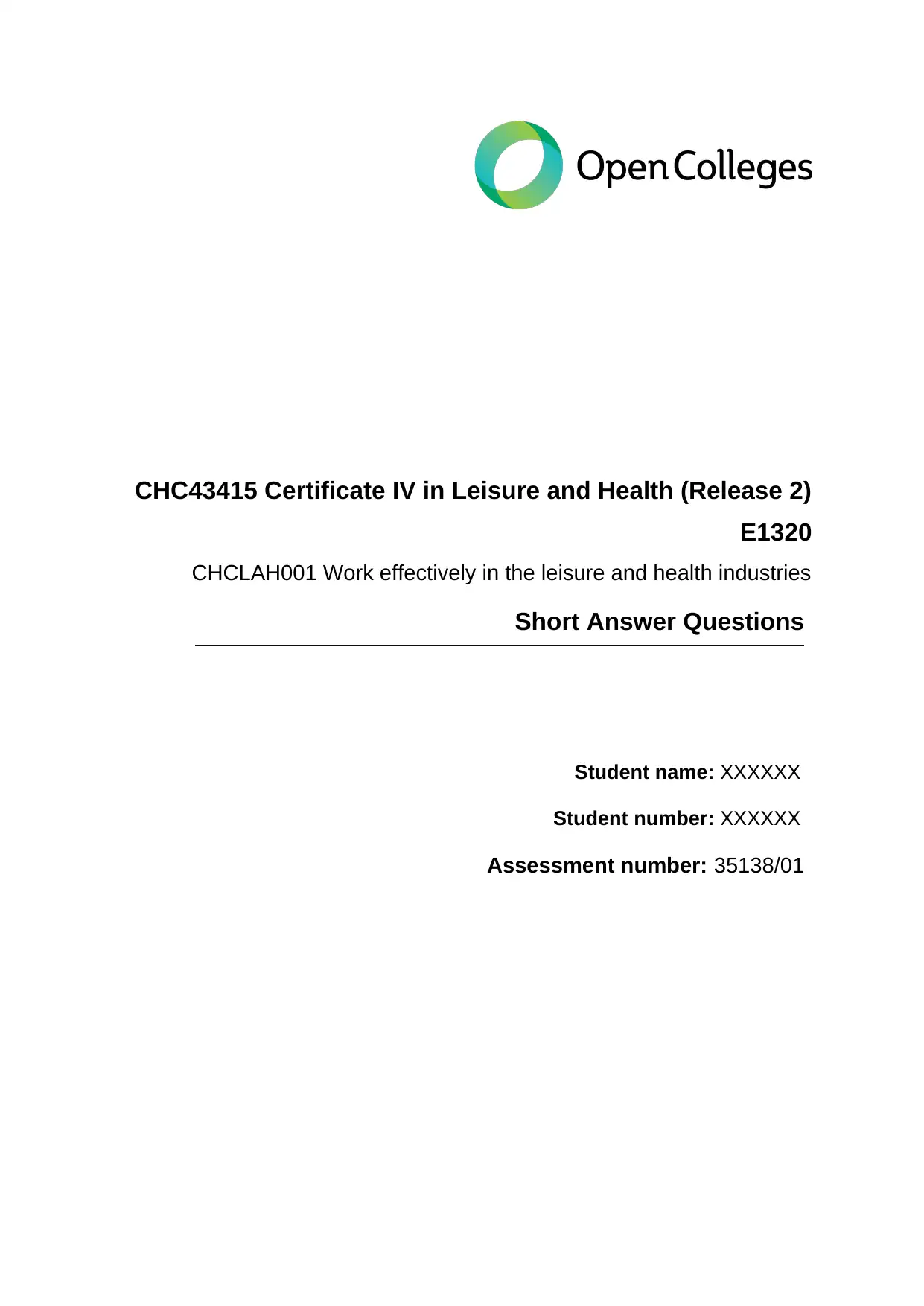
CHC43415 Certificate IV in Leisure and Health (Release 2)
E1320
CHCLAH001 Work effectively in the leisure and health industries
Short Answer Questions
Student name: XXXXXX
Student number: XXXXXX
Assessment number: 35138/01
E1320
CHCLAH001 Work effectively in the leisure and health industries
Short Answer Questions
Student name: XXXXXX
Student number: XXXXXX
Assessment number: 35138/01
Secure Best Marks with AI Grader
Need help grading? Try our AI Grader for instant feedback on your assignments.
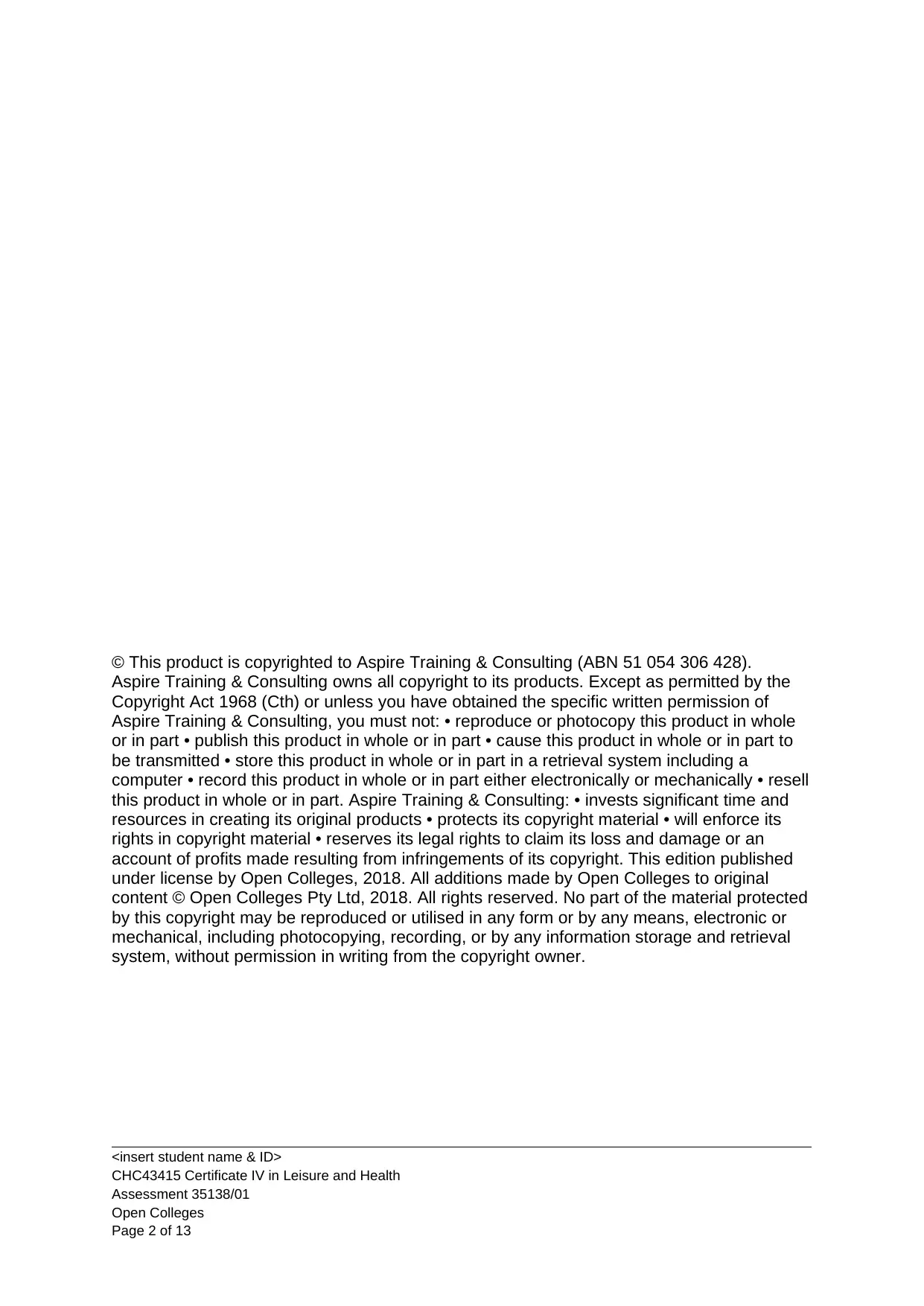
© This product is copyrighted to Aspire Training & Consulting (ABN 51 054 306 428).
Aspire Training & Consulting owns all copyright to its products. Except as permitted by the
Copyright Act 1968 (Cth) or unless you have obtained the specific written permission of
Aspire Training & Consulting, you must not: • reproduce or photocopy this product in whole
or in part • publish this product in whole or in part • cause this product in whole or in part to
be transmitted • store this product in whole or in part in a retrieval system including a
computer • record this product in whole or in part either electronically or mechanically • resell
this product in whole or in part. Aspire Training & Consulting: • invests significant time and
resources in creating its original products • protects its copyright material • will enforce its
rights in copyright material • reserves its legal rights to claim its loss and damage or an
account of profits made resulting from infringements of its copyright. This edition published
under license by Open Colleges, 2018. All additions made by Open Colleges to original
content © Open Colleges Pty Ltd, 2018. All rights reserved. No part of the material protected
by this copyright may be reproduced or utilised in any form or by any means, electronic or
mechanical, including photocopying, recording, or by any information storage and retrieval
system, without permission in writing from the copyright owner.
<insert student name & ID>
CHC43415 Certificate IV in Leisure and Health
Assessment 35138/01
Open Colleges
Page 2 of 13
Aspire Training & Consulting owns all copyright to its products. Except as permitted by the
Copyright Act 1968 (Cth) or unless you have obtained the specific written permission of
Aspire Training & Consulting, you must not: • reproduce or photocopy this product in whole
or in part • publish this product in whole or in part • cause this product in whole or in part to
be transmitted • store this product in whole or in part in a retrieval system including a
computer • record this product in whole or in part either electronically or mechanically • resell
this product in whole or in part. Aspire Training & Consulting: • invests significant time and
resources in creating its original products • protects its copyright material • will enforce its
rights in copyright material • reserves its legal rights to claim its loss and damage or an
account of profits made resulting from infringements of its copyright. This edition published
under license by Open Colleges, 2018. All additions made by Open Colleges to original
content © Open Colleges Pty Ltd, 2018. All rights reserved. No part of the material protected
by this copyright may be reproduced or utilised in any form or by any means, electronic or
mechanical, including photocopying, recording, or by any information storage and retrieval
system, without permission in writing from the copyright owner.
<insert student name & ID>
CHC43415 Certificate IV in Leisure and Health
Assessment 35138/01
Open Colleges
Page 2 of 13
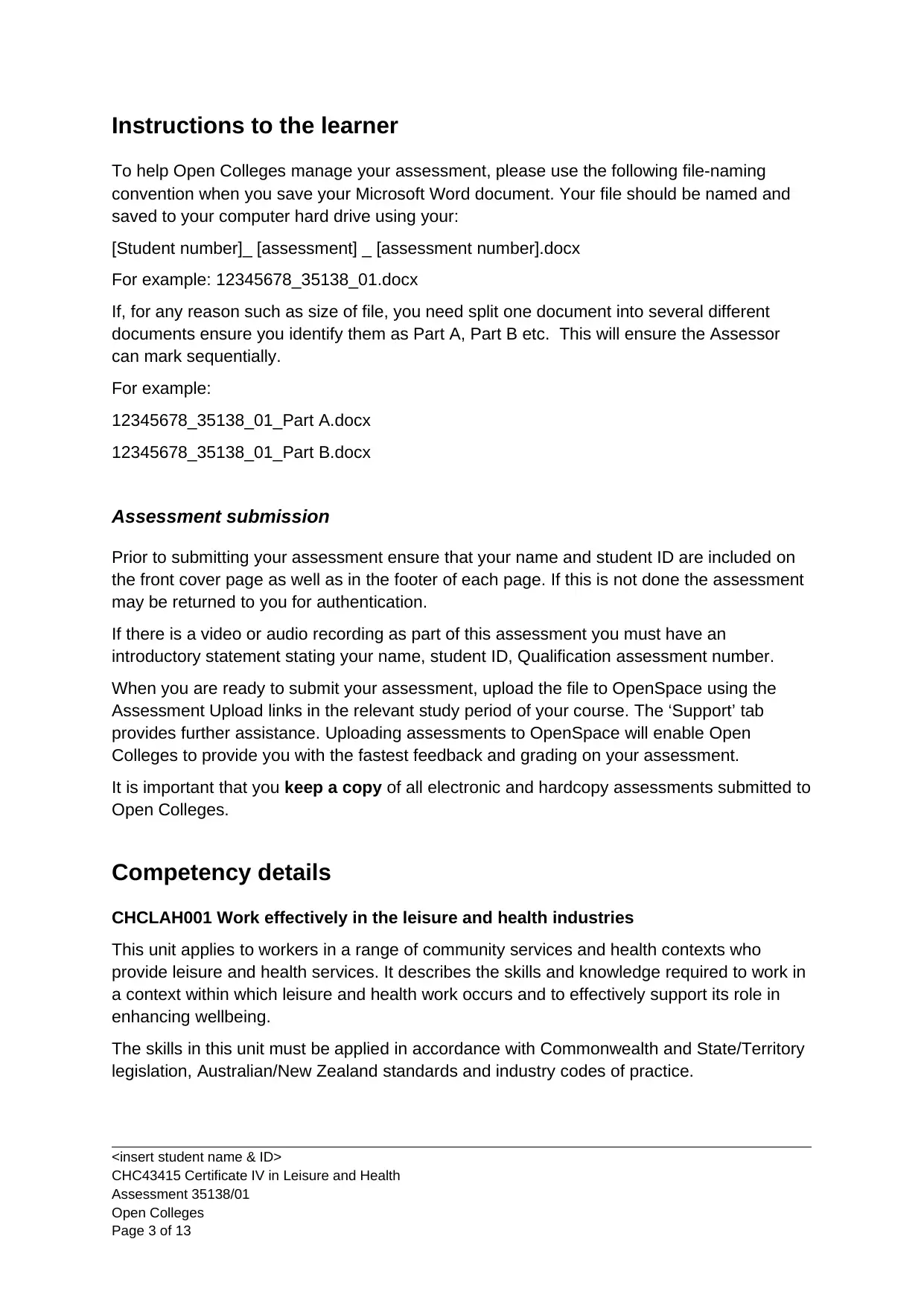
Instructions to the learner
To help Open Colleges manage your assessment, please use the following file-naming
convention when you save your Microsoft Word document. Your file should be named and
saved to your computer hard drive using your:
[Student number]_ [assessment] _ [assessment number].docx
For example: 12345678_35138_01.docx
If, for any reason such as size of file, you need split one document into several different
documents ensure you identify them as Part A, Part B etc. This will ensure the Assessor
can mark sequentially.
For example:
12345678_35138_01_Part A.docx
12345678_35138_01_Part B.docx
Assessment submission
Prior to submitting your assessment ensure that your name and student ID are included on
the front cover page as well as in the footer of each page. If this is not done the assessment
may be returned to you for authentication.
If there is a video or audio recording as part of this assessment you must have an
introductory statement stating your name, student ID, Qualification assessment number.
When you are ready to submit your assessment, upload the file to OpenSpace using the
Assessment Upload links in the relevant study period of your course. The ‘Support’ tab
provides further assistance. Uploading assessments to OpenSpace will enable Open
Colleges to provide you with the fastest feedback and grading on your assessment.
It is important that you keep a copy of all electronic and hardcopy assessments submitted to
Open Colleges.
Competency details
CHCLAH001 Work effectively in the leisure and health industries
This unit applies to workers in a range of community services and health contexts who
provide leisure and health services. It describes the skills and knowledge required to work in
a context within which leisure and health work occurs and to effectively support its role in
enhancing wellbeing.
The skills in this unit must be applied in accordance with Commonwealth and State/Territory
legislation, Australian/New Zealand standards and industry codes of practice.
<insert student name & ID>
CHC43415 Certificate IV in Leisure and Health
Assessment 35138/01
Open Colleges
Page 3 of 13
To help Open Colleges manage your assessment, please use the following file-naming
convention when you save your Microsoft Word document. Your file should be named and
saved to your computer hard drive using your:
[Student number]_ [assessment] _ [assessment number].docx
For example: 12345678_35138_01.docx
If, for any reason such as size of file, you need split one document into several different
documents ensure you identify them as Part A, Part B etc. This will ensure the Assessor
can mark sequentially.
For example:
12345678_35138_01_Part A.docx
12345678_35138_01_Part B.docx
Assessment submission
Prior to submitting your assessment ensure that your name and student ID are included on
the front cover page as well as in the footer of each page. If this is not done the assessment
may be returned to you for authentication.
If there is a video or audio recording as part of this assessment you must have an
introductory statement stating your name, student ID, Qualification assessment number.
When you are ready to submit your assessment, upload the file to OpenSpace using the
Assessment Upload links in the relevant study period of your course. The ‘Support’ tab
provides further assistance. Uploading assessments to OpenSpace will enable Open
Colleges to provide you with the fastest feedback and grading on your assessment.
It is important that you keep a copy of all electronic and hardcopy assessments submitted to
Open Colleges.
Competency details
CHCLAH001 Work effectively in the leisure and health industries
This unit applies to workers in a range of community services and health contexts who
provide leisure and health services. It describes the skills and knowledge required to work in
a context within which leisure and health work occurs and to effectively support its role in
enhancing wellbeing.
The skills in this unit must be applied in accordance with Commonwealth and State/Territory
legislation, Australian/New Zealand standards and industry codes of practice.
<insert student name & ID>
CHC43415 Certificate IV in Leisure and Health
Assessment 35138/01
Open Colleges
Page 3 of 13
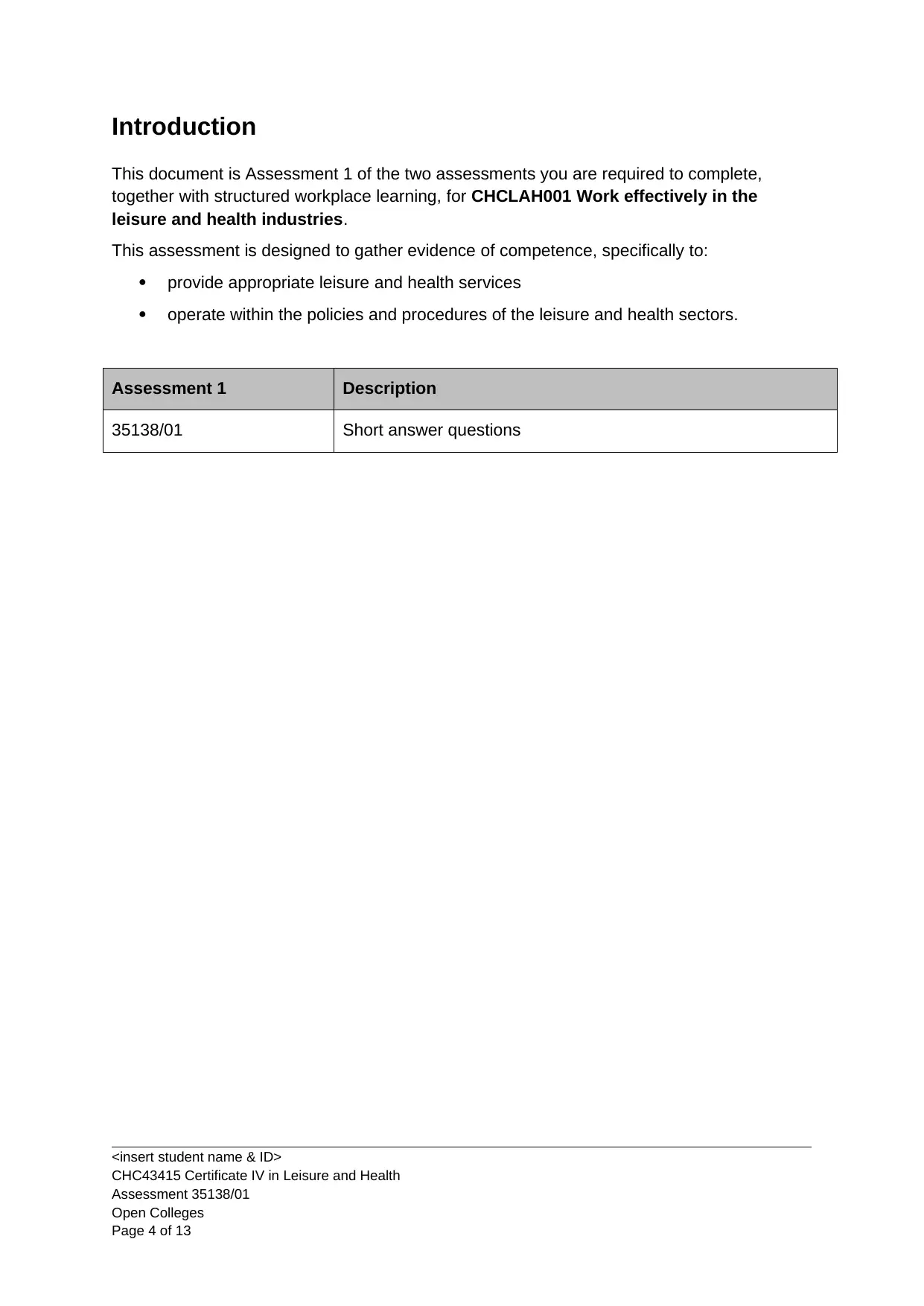
Introduction
This document is Assessment 1 of the two assessments you are required to complete,
together with structured workplace learning, for CHCLAH001 Work effectively in the
leisure and health industries.
This assessment is designed to gather evidence of competence, specifically to:
provide appropriate leisure and health services
operate within the policies and procedures of the leisure and health sectors.
Assessment 1 Description
35138/01 Short answer questions
<insert student name & ID>
CHC43415 Certificate IV in Leisure and Health
Assessment 35138/01
Open Colleges
Page 4 of 13
This document is Assessment 1 of the two assessments you are required to complete,
together with structured workplace learning, for CHCLAH001 Work effectively in the
leisure and health industries.
This assessment is designed to gather evidence of competence, specifically to:
provide appropriate leisure and health services
operate within the policies and procedures of the leisure and health sectors.
Assessment 1 Description
35138/01 Short answer questions
<insert student name & ID>
CHC43415 Certificate IV in Leisure and Health
Assessment 35138/01
Open Colleges
Page 4 of 13
Secure Best Marks with AI Grader
Need help grading? Try our AI Grader for instant feedback on your assignments.
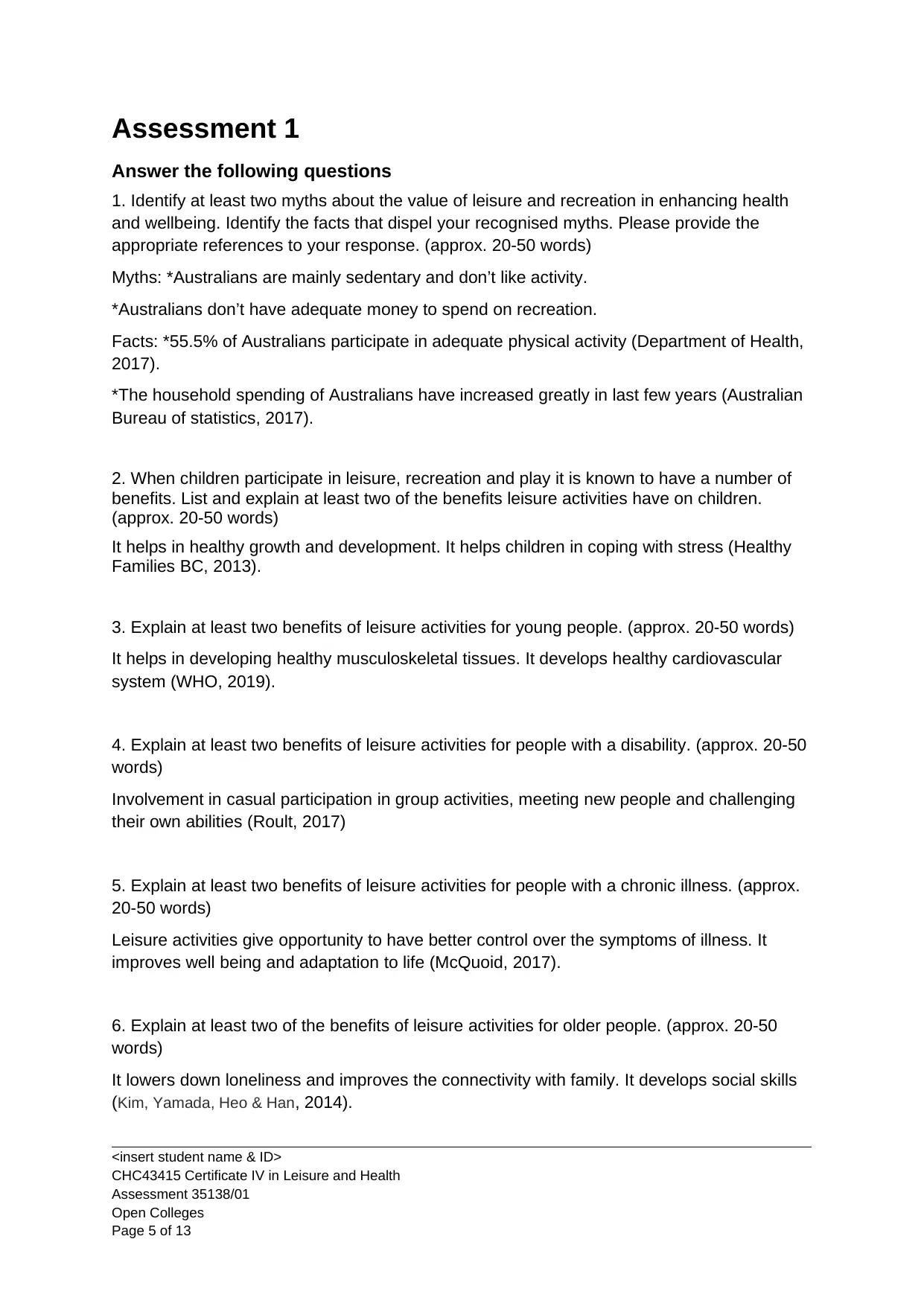
Assessment 1
Answer the following questions
1. Identify at least two myths about the value of leisure and recreation in enhancing health
and wellbeing. Identify the facts that dispel your recognised myths. Please provide the
appropriate references to your response. (approx. 20-50 words)
Myths: *Australians are mainly sedentary and don’t like activity.
*Australians don’t have adequate money to spend on recreation.
Facts: *55.5% of Australians participate in adequate physical activity (Department of Health,
2017).
*The household spending of Australians have increased greatly in last few years (Australian
Bureau of statistics, 2017).
2. When children participate in leisure, recreation and play it is known to have a number of
benefits. List and explain at least two of the benefits leisure activities have on children.
(approx. 20-50 words)
It helps in healthy growth and development. It helps children in coping with stress (Healthy
Families BC, 2013).
3. Explain at least two benefits of leisure activities for young people. (approx. 20-50 words)
It helps in developing healthy musculoskeletal tissues. It develops healthy cardiovascular
system (WHO, 2019).
4. Explain at least two benefits of leisure activities for people with a disability. (approx. 20-50
words)
Involvement in casual participation in group activities, meeting new people and challenging
their own abilities (Roult, 2017)
5. Explain at least two benefits of leisure activities for people with a chronic illness. (approx.
20-50 words)
Leisure activities give opportunity to have better control over the symptoms of illness. It
improves well being and adaptation to life (McQuoid, 2017).
6. Explain at least two of the benefits of leisure activities for older people. (approx. 20-50
words)
It lowers down loneliness and improves the connectivity with family. It develops social skills
(Kim, Yamada, Heo & Han, 2014).
<insert student name & ID>
CHC43415 Certificate IV in Leisure and Health
Assessment 35138/01
Open Colleges
Page 5 of 13
Answer the following questions
1. Identify at least two myths about the value of leisure and recreation in enhancing health
and wellbeing. Identify the facts that dispel your recognised myths. Please provide the
appropriate references to your response. (approx. 20-50 words)
Myths: *Australians are mainly sedentary and don’t like activity.
*Australians don’t have adequate money to spend on recreation.
Facts: *55.5% of Australians participate in adequate physical activity (Department of Health,
2017).
*The household spending of Australians have increased greatly in last few years (Australian
Bureau of statistics, 2017).
2. When children participate in leisure, recreation and play it is known to have a number of
benefits. List and explain at least two of the benefits leisure activities have on children.
(approx. 20-50 words)
It helps in healthy growth and development. It helps children in coping with stress (Healthy
Families BC, 2013).
3. Explain at least two benefits of leisure activities for young people. (approx. 20-50 words)
It helps in developing healthy musculoskeletal tissues. It develops healthy cardiovascular
system (WHO, 2019).
4. Explain at least two benefits of leisure activities for people with a disability. (approx. 20-50
words)
Involvement in casual participation in group activities, meeting new people and challenging
their own abilities (Roult, 2017)
5. Explain at least two benefits of leisure activities for people with a chronic illness. (approx.
20-50 words)
Leisure activities give opportunity to have better control over the symptoms of illness. It
improves well being and adaptation to life (McQuoid, 2017).
6. Explain at least two of the benefits of leisure activities for older people. (approx. 20-50
words)
It lowers down loneliness and improves the connectivity with family. It develops social skills
(Kim, Yamada, Heo & Han, 2014).
<insert student name & ID>
CHC43415 Certificate IV in Leisure and Health
Assessment 35138/01
Open Colleges
Page 5 of 13
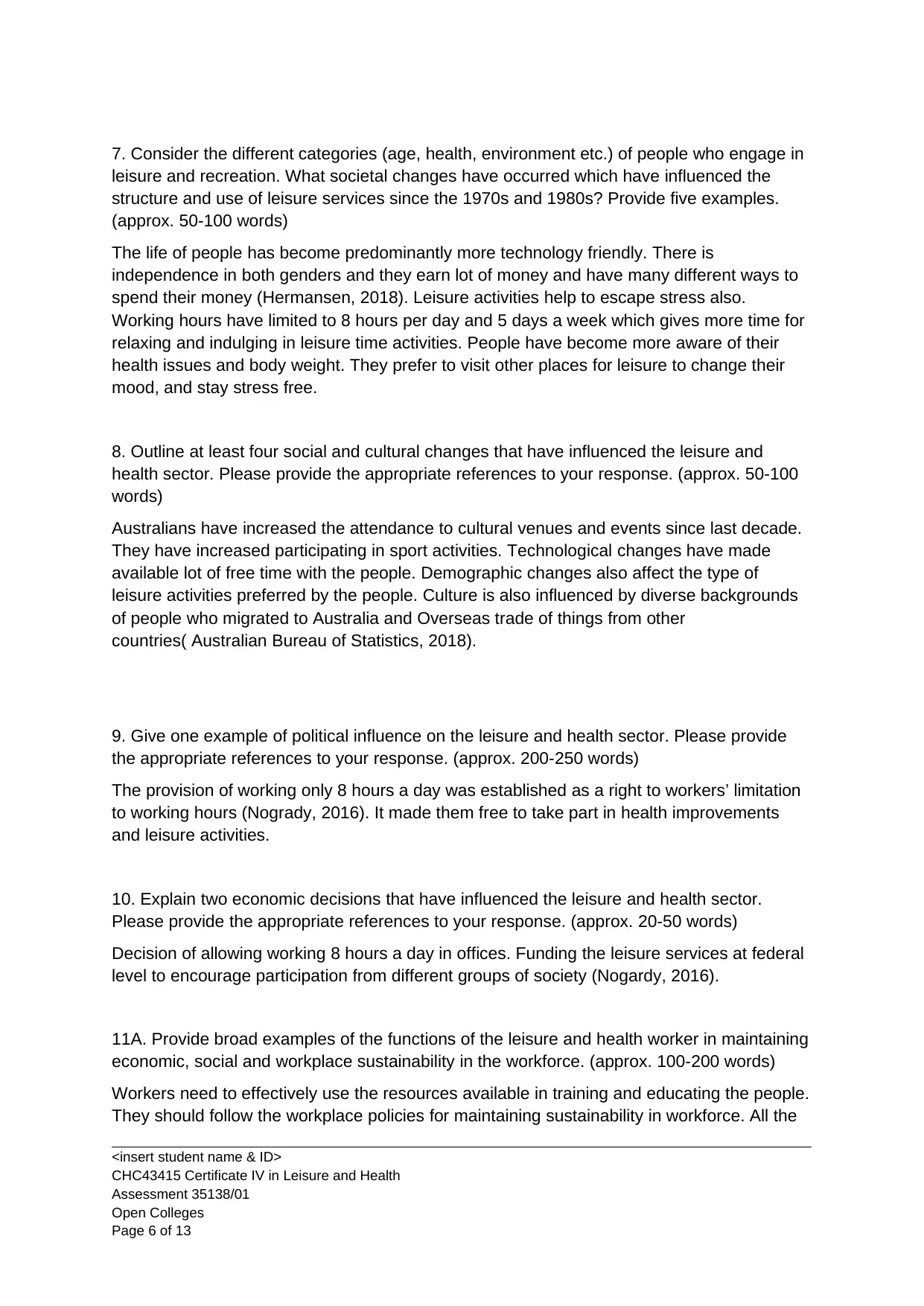
7. Consider the different categories (age, health, environment etc.) of people who engage in
leisure and recreation. What societal changes have occurred which have influenced the
structure and use of leisure services since the 1970s and 1980s? Provide five examples.
(approx. 50-100 words)
The life of people has become predominantly more technology friendly. There is
independence in both genders and they earn lot of money and have many different ways to
spend their money (Hermansen, 2018). Leisure activities help to escape stress also.
Working hours have limited to 8 hours per day and 5 days a week which gives more time for
relaxing and indulging in leisure time activities. People have become more aware of their
health issues and body weight. They prefer to visit other places for leisure to change their
mood, and stay stress free.
8. Outline at least four social and cultural changes that have influenced the leisure and
health sector. Please provide the appropriate references to your response. (approx. 50-100
words)
Australians have increased the attendance to cultural venues and events since last decade.
They have increased participating in sport activities. Technological changes have made
available lot of free time with the people. Demographic changes also affect the type of
leisure activities preferred by the people. Culture is also influenced by diverse backgrounds
of people who migrated to Australia and Overseas trade of things from other
countries( Australian Bureau of Statistics, 2018).
9. Give one example of political influence on the leisure and health sector. Please provide
the appropriate references to your response. (approx. 200-250 words)
The provision of working only 8 hours a day was established as a right to workers’ limitation
to working hours (Nogrady, 2016). It made them free to take part in health improvements
and leisure activities.
10. Explain two economic decisions that have influenced the leisure and health sector.
Please provide the appropriate references to your response. (approx. 20-50 words)
Decision of allowing working 8 hours a day in offices. Funding the leisure services at federal
level to encourage participation from different groups of society (Nogardy, 2016).
11A. Provide broad examples of the functions of the leisure and health worker in maintaining
economic, social and workplace sustainability in the workforce. (approx. 100-200 words)
Workers need to effectively use the resources available in training and educating the people.
They should follow the workplace policies for maintaining sustainability in workforce. All the
<insert student name & ID>
CHC43415 Certificate IV in Leisure and Health
Assessment 35138/01
Open Colleges
Page 6 of 13
leisure and recreation. What societal changes have occurred which have influenced the
structure and use of leisure services since the 1970s and 1980s? Provide five examples.
(approx. 50-100 words)
The life of people has become predominantly more technology friendly. There is
independence in both genders and they earn lot of money and have many different ways to
spend their money (Hermansen, 2018). Leisure activities help to escape stress also.
Working hours have limited to 8 hours per day and 5 days a week which gives more time for
relaxing and indulging in leisure time activities. People have become more aware of their
health issues and body weight. They prefer to visit other places for leisure to change their
mood, and stay stress free.
8. Outline at least four social and cultural changes that have influenced the leisure and
health sector. Please provide the appropriate references to your response. (approx. 50-100
words)
Australians have increased the attendance to cultural venues and events since last decade.
They have increased participating in sport activities. Technological changes have made
available lot of free time with the people. Demographic changes also affect the type of
leisure activities preferred by the people. Culture is also influenced by diverse backgrounds
of people who migrated to Australia and Overseas trade of things from other
countries( Australian Bureau of Statistics, 2018).
9. Give one example of political influence on the leisure and health sector. Please provide
the appropriate references to your response. (approx. 200-250 words)
The provision of working only 8 hours a day was established as a right to workers’ limitation
to working hours (Nogrady, 2016). It made them free to take part in health improvements
and leisure activities.
10. Explain two economic decisions that have influenced the leisure and health sector.
Please provide the appropriate references to your response. (approx. 20-50 words)
Decision of allowing working 8 hours a day in offices. Funding the leisure services at federal
level to encourage participation from different groups of society (Nogardy, 2016).
11A. Provide broad examples of the functions of the leisure and health worker in maintaining
economic, social and workplace sustainability in the workforce. (approx. 100-200 words)
Workers need to effectively use the resources available in training and educating the people.
They should follow the workplace policies for maintaining sustainability in workforce. All the
<insert student name & ID>
CHC43415 Certificate IV in Leisure and Health
Assessment 35138/01
Open Colleges
Page 6 of 13
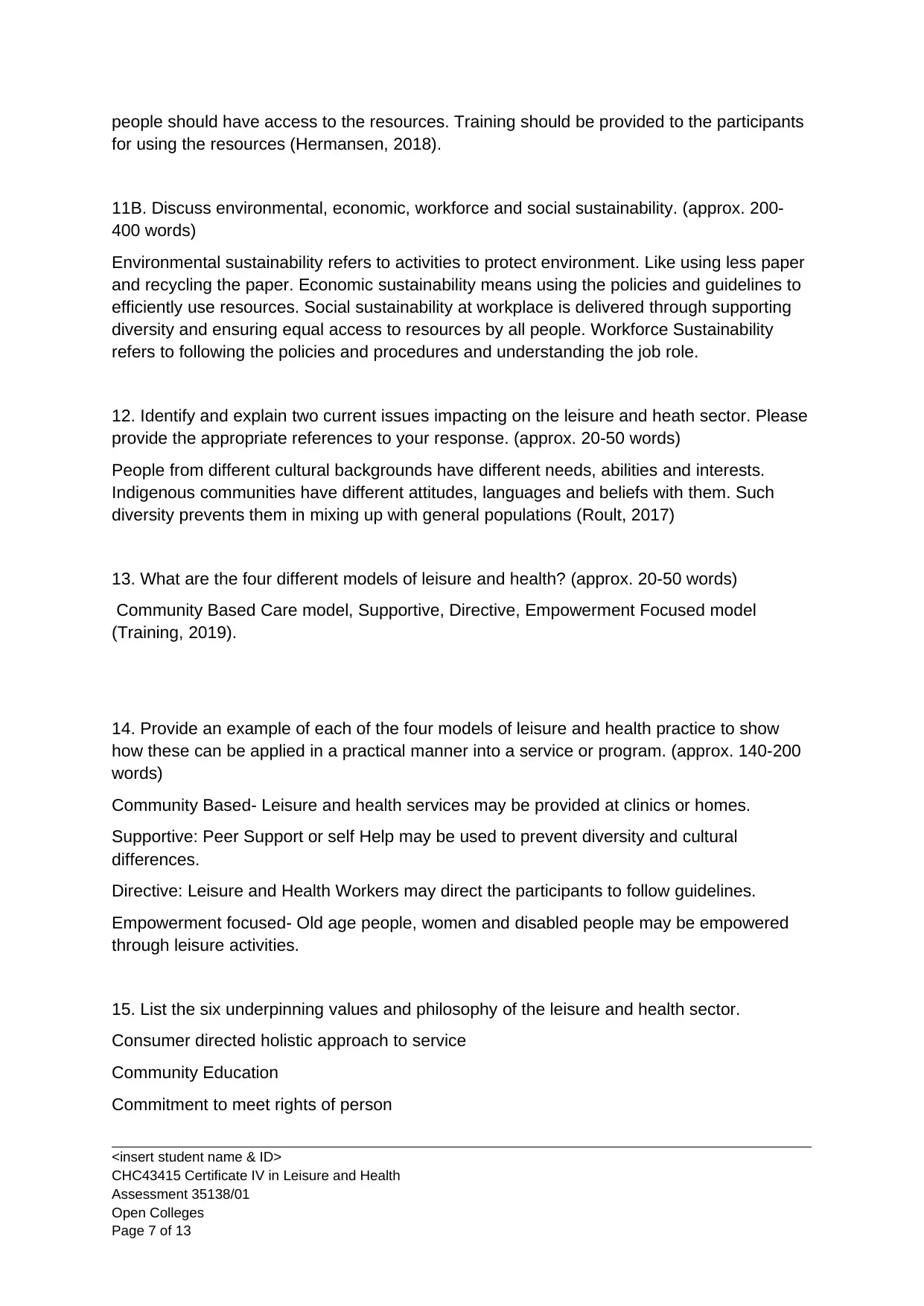
people should have access to the resources. Training should be provided to the participants
for using the resources (Hermansen, 2018).
11B. Discuss environmental, economic, workforce and social sustainability. (approx. 200-
400 words)
Environmental sustainability refers to activities to protect environment. Like using less paper
and recycling the paper. Economic sustainability means using the policies and guidelines to
efficiently use resources. Social sustainability at workplace is delivered through supporting
diversity and ensuring equal access to resources by all people. Workforce Sustainability
refers to following the policies and procedures and understanding the job role.
12. Identify and explain two current issues impacting on the leisure and heath sector. Please
provide the appropriate references to your response. (approx. 20-50 words)
People from different cultural backgrounds have different needs, abilities and interests.
Indigenous communities have different attitudes, languages and beliefs with them. Such
diversity prevents them in mixing up with general populations (Roult, 2017)
13. What are the four different models of leisure and health? (approx. 20-50 words)
Community Based Care model, Supportive, Directive, Empowerment Focused model
(Training, 2019).
14. Provide an example of each of the four models of leisure and health practice to show
how these can be applied in a practical manner into a service or program. (approx. 140-200
words)
Community Based- Leisure and health services may be provided at clinics or homes.
Supportive: Peer Support or self Help may be used to prevent diversity and cultural
differences.
Directive: Leisure and Health Workers may direct the participants to follow guidelines.
Empowerment focused- Old age people, women and disabled people may be empowered
through leisure activities.
15. List the six underpinning values and philosophy of the leisure and health sector.
Consumer directed holistic approach to service
Community Education
Commitment to meet rights of person
<insert student name & ID>
CHC43415 Certificate IV in Leisure and Health
Assessment 35138/01
Open Colleges
Page 7 of 13
for using the resources (Hermansen, 2018).
11B. Discuss environmental, economic, workforce and social sustainability. (approx. 200-
400 words)
Environmental sustainability refers to activities to protect environment. Like using less paper
and recycling the paper. Economic sustainability means using the policies and guidelines to
efficiently use resources. Social sustainability at workplace is delivered through supporting
diversity and ensuring equal access to resources by all people. Workforce Sustainability
refers to following the policies and procedures and understanding the job role.
12. Identify and explain two current issues impacting on the leisure and heath sector. Please
provide the appropriate references to your response. (approx. 20-50 words)
People from different cultural backgrounds have different needs, abilities and interests.
Indigenous communities have different attitudes, languages and beliefs with them. Such
diversity prevents them in mixing up with general populations (Roult, 2017)
13. What are the four different models of leisure and health? (approx. 20-50 words)
Community Based Care model, Supportive, Directive, Empowerment Focused model
(Training, 2019).
14. Provide an example of each of the four models of leisure and health practice to show
how these can be applied in a practical manner into a service or program. (approx. 140-200
words)
Community Based- Leisure and health services may be provided at clinics or homes.
Supportive: Peer Support or self Help may be used to prevent diversity and cultural
differences.
Directive: Leisure and Health Workers may direct the participants to follow guidelines.
Empowerment focused- Old age people, women and disabled people may be empowered
through leisure activities.
15. List the six underpinning values and philosophy of the leisure and health sector.
Consumer directed holistic approach to service
Community Education
Commitment to meet rights of person
<insert student name & ID>
CHC43415 Certificate IV in Leisure and Health
Assessment 35138/01
Open Colleges
Page 7 of 13
Paraphrase This Document
Need a fresh take? Get an instant paraphrase of this document with our AI Paraphraser
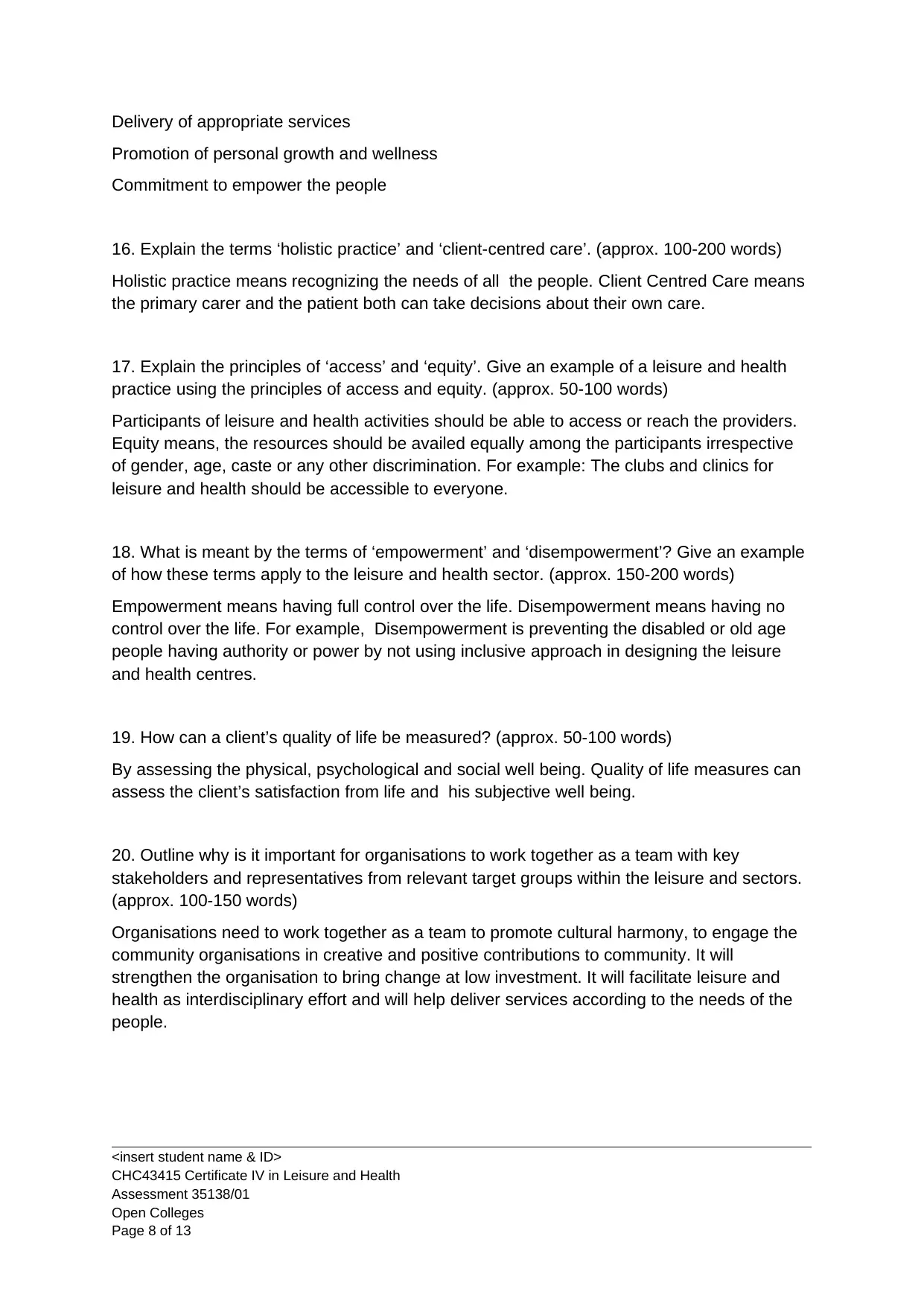
Delivery of appropriate services
Promotion of personal growth and wellness
Commitment to empower the people
16. Explain the terms ‘holistic practice’ and ‘client-centred care’. (approx. 100-200 words)
Holistic practice means recognizing the needs of all the people. Client Centred Care means
the primary carer and the patient both can take decisions about their own care.
17. Explain the principles of ‘access’ and ‘equity’. Give an example of a leisure and health
practice using the principles of access and equity. (approx. 50-100 words)
Participants of leisure and health activities should be able to access or reach the providers.
Equity means, the resources should be availed equally among the participants irrespective
of gender, age, caste or any other discrimination. For example: The clubs and clinics for
leisure and health should be accessible to everyone.
18. What is meant by the terms of ‘empowerment’ and ‘disempowerment’? Give an example
of how these terms apply to the leisure and health sector. (approx. 150-200 words)
Empowerment means having full control over the life. Disempowerment means having no
control over the life. For example, Disempowerment is preventing the disabled or old age
people having authority or power by not using inclusive approach in designing the leisure
and health centres.
19. How can a client’s quality of life be measured? (approx. 50-100 words)
By assessing the physical, psychological and social well being. Quality of life measures can
assess the client’s satisfaction from life and his subjective well being.
20. Outline why is it important for organisations to work together as a team with key
stakeholders and representatives from relevant target groups within the leisure and sectors.
(approx. 100-150 words)
Organisations need to work together as a team to promote cultural harmony, to engage the
community organisations in creative and positive contributions to community. It will
strengthen the organisation to bring change at low investment. It will facilitate leisure and
health as interdisciplinary effort and will help deliver services according to the needs of the
people.
<insert student name & ID>
CHC43415 Certificate IV in Leisure and Health
Assessment 35138/01
Open Colleges
Page 8 of 13
Promotion of personal growth and wellness
Commitment to empower the people
16. Explain the terms ‘holistic practice’ and ‘client-centred care’. (approx. 100-200 words)
Holistic practice means recognizing the needs of all the people. Client Centred Care means
the primary carer and the patient both can take decisions about their own care.
17. Explain the principles of ‘access’ and ‘equity’. Give an example of a leisure and health
practice using the principles of access and equity. (approx. 50-100 words)
Participants of leisure and health activities should be able to access or reach the providers.
Equity means, the resources should be availed equally among the participants irrespective
of gender, age, caste or any other discrimination. For example: The clubs and clinics for
leisure and health should be accessible to everyone.
18. What is meant by the terms of ‘empowerment’ and ‘disempowerment’? Give an example
of how these terms apply to the leisure and health sector. (approx. 150-200 words)
Empowerment means having full control over the life. Disempowerment means having no
control over the life. For example, Disempowerment is preventing the disabled or old age
people having authority or power by not using inclusive approach in designing the leisure
and health centres.
19. How can a client’s quality of life be measured? (approx. 50-100 words)
By assessing the physical, psychological and social well being. Quality of life measures can
assess the client’s satisfaction from life and his subjective well being.
20. Outline why is it important for organisations to work together as a team with key
stakeholders and representatives from relevant target groups within the leisure and sectors.
(approx. 100-150 words)
Organisations need to work together as a team to promote cultural harmony, to engage the
community organisations in creative and positive contributions to community. It will
strengthen the organisation to bring change at low investment. It will facilitate leisure and
health as interdisciplinary effort and will help deliver services according to the needs of the
people.
<insert student name & ID>
CHC43415 Certificate IV in Leisure and Health
Assessment 35138/01
Open Colleges
Page 8 of 13
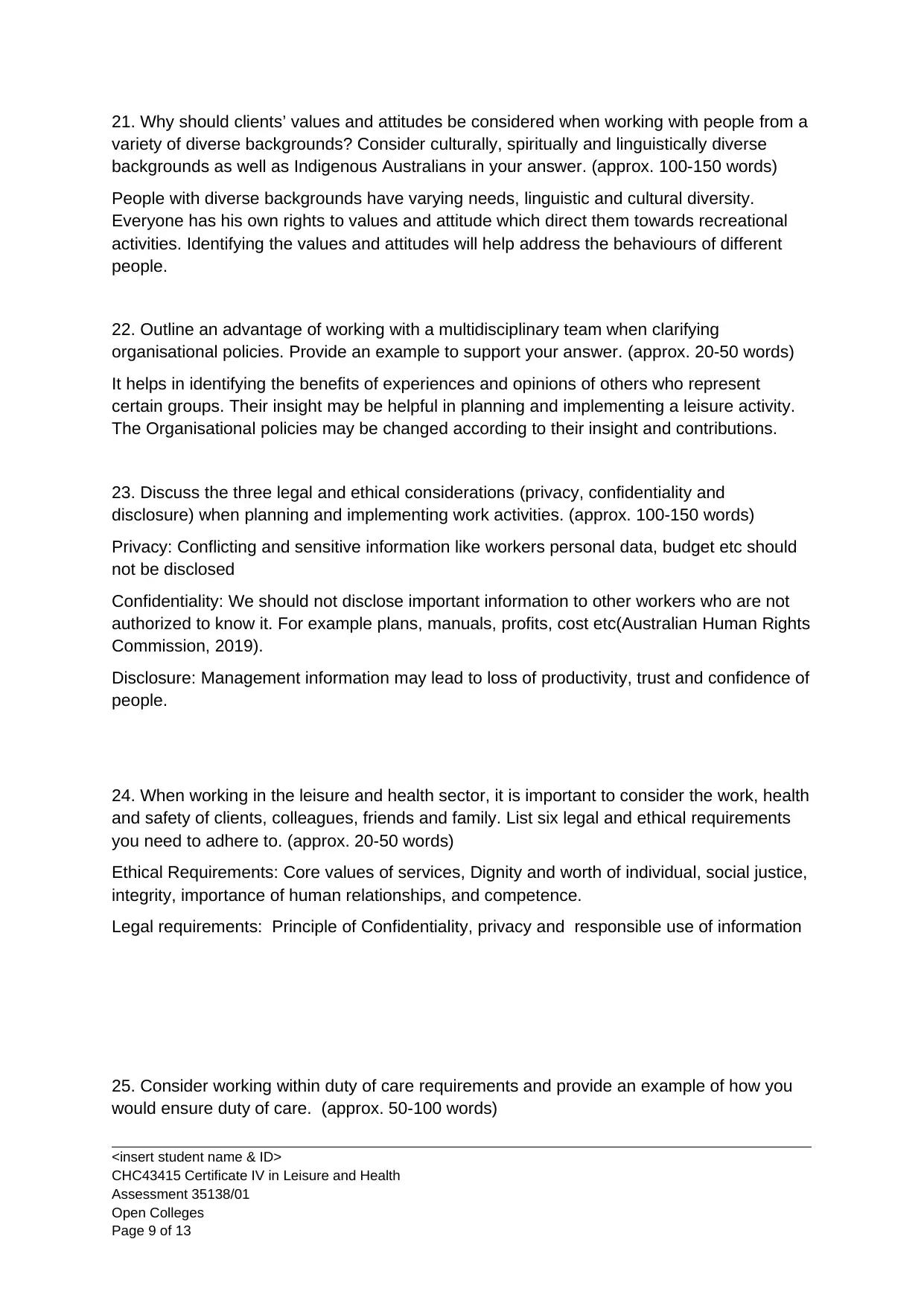
21. Why should clients’ values and attitudes be considered when working with people from a
variety of diverse backgrounds? Consider culturally, spiritually and linguistically diverse
backgrounds as well as Indigenous Australians in your answer. (approx. 100-150 words)
People with diverse backgrounds have varying needs, linguistic and cultural diversity.
Everyone has his own rights to values and attitude which direct them towards recreational
activities. Identifying the values and attitudes will help address the behaviours of different
people.
22. Outline an advantage of working with a multidisciplinary team when clarifying
organisational policies. Provide an example to support your answer. (approx. 20-50 words)
It helps in identifying the benefits of experiences and opinions of others who represent
certain groups. Their insight may be helpful in planning and implementing a leisure activity.
The Organisational policies may be changed according to their insight and contributions.
23. Discuss the three legal and ethical considerations (privacy, confidentiality and
disclosure) when planning and implementing work activities. (approx. 100-150 words)
Privacy: Conflicting and sensitive information like workers personal data, budget etc should
not be disclosed
Confidentiality: We should not disclose important information to other workers who are not
authorized to know it. For example plans, manuals, profits, cost etc(Australian Human Rights
Commission, 2019).
Disclosure: Management information may lead to loss of productivity, trust and confidence of
people.
24. When working in the leisure and health sector, it is important to consider the work, health
and safety of clients, colleagues, friends and family. List six legal and ethical requirements
you need to adhere to. (approx. 20-50 words)
Ethical Requirements: Core values of services, Dignity and worth of individual, social justice,
integrity, importance of human relationships, and competence.
Legal requirements: Principle of Confidentiality, privacy and responsible use of information
25. Consider working within duty of care requirements and provide an example of how you
would ensure duty of care. (approx. 50-100 words)
<insert student name & ID>
CHC43415 Certificate IV in Leisure and Health
Assessment 35138/01
Open Colleges
Page 9 of 13
variety of diverse backgrounds? Consider culturally, spiritually and linguistically diverse
backgrounds as well as Indigenous Australians in your answer. (approx. 100-150 words)
People with diverse backgrounds have varying needs, linguistic and cultural diversity.
Everyone has his own rights to values and attitude which direct them towards recreational
activities. Identifying the values and attitudes will help address the behaviours of different
people.
22. Outline an advantage of working with a multidisciplinary team when clarifying
organisational policies. Provide an example to support your answer. (approx. 20-50 words)
It helps in identifying the benefits of experiences and opinions of others who represent
certain groups. Their insight may be helpful in planning and implementing a leisure activity.
The Organisational policies may be changed according to their insight and contributions.
23. Discuss the three legal and ethical considerations (privacy, confidentiality and
disclosure) when planning and implementing work activities. (approx. 100-150 words)
Privacy: Conflicting and sensitive information like workers personal data, budget etc should
not be disclosed
Confidentiality: We should not disclose important information to other workers who are not
authorized to know it. For example plans, manuals, profits, cost etc(Australian Human Rights
Commission, 2019).
Disclosure: Management information may lead to loss of productivity, trust and confidence of
people.
24. When working in the leisure and health sector, it is important to consider the work, health
and safety of clients, colleagues, friends and family. List six legal and ethical requirements
you need to adhere to. (approx. 20-50 words)
Ethical Requirements: Core values of services, Dignity and worth of individual, social justice,
integrity, importance of human relationships, and competence.
Legal requirements: Principle of Confidentiality, privacy and responsible use of information
25. Consider working within duty of care requirements and provide an example of how you
would ensure duty of care. (approx. 50-100 words)
<insert student name & ID>
CHC43415 Certificate IV in Leisure and Health
Assessment 35138/01
Open Colleges
Page 9 of 13
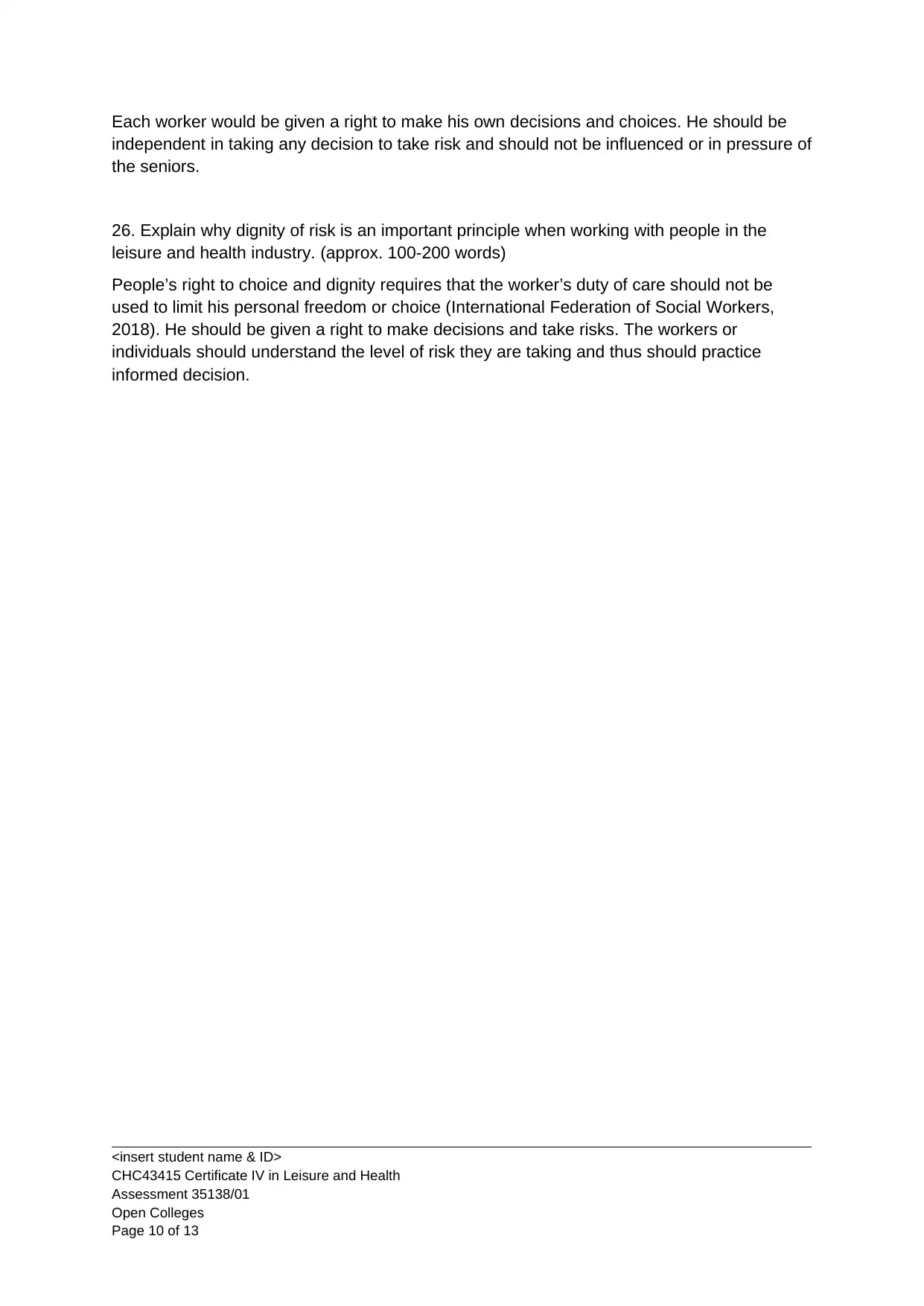
Each worker would be given a right to make his own decisions and choices. He should be
independent in taking any decision to take risk and should not be influenced or in pressure of
the seniors.
26. Explain why dignity of risk is an important principle when working with people in the
leisure and health industry. (approx. 100-200 words)
People’s right to choice and dignity requires that the worker’s duty of care should not be
used to limit his personal freedom or choice (International Federation of Social Workers,
2018). He should be given a right to make decisions and take risks. The workers or
individuals should understand the level of risk they are taking and thus should practice
informed decision.
<insert student name & ID>
CHC43415 Certificate IV in Leisure and Health
Assessment 35138/01
Open Colleges
Page 10 of 13
independent in taking any decision to take risk and should not be influenced or in pressure of
the seniors.
26. Explain why dignity of risk is an important principle when working with people in the
leisure and health industry. (approx. 100-200 words)
People’s right to choice and dignity requires that the worker’s duty of care should not be
used to limit his personal freedom or choice (International Federation of Social Workers,
2018). He should be given a right to make decisions and take risks. The workers or
individuals should understand the level of risk they are taking and thus should practice
informed decision.
<insert student name & ID>
CHC43415 Certificate IV in Leisure and Health
Assessment 35138/01
Open Colleges
Page 10 of 13
Secure Best Marks with AI Grader
Need help grading? Try our AI Grader for instant feedback on your assignments.
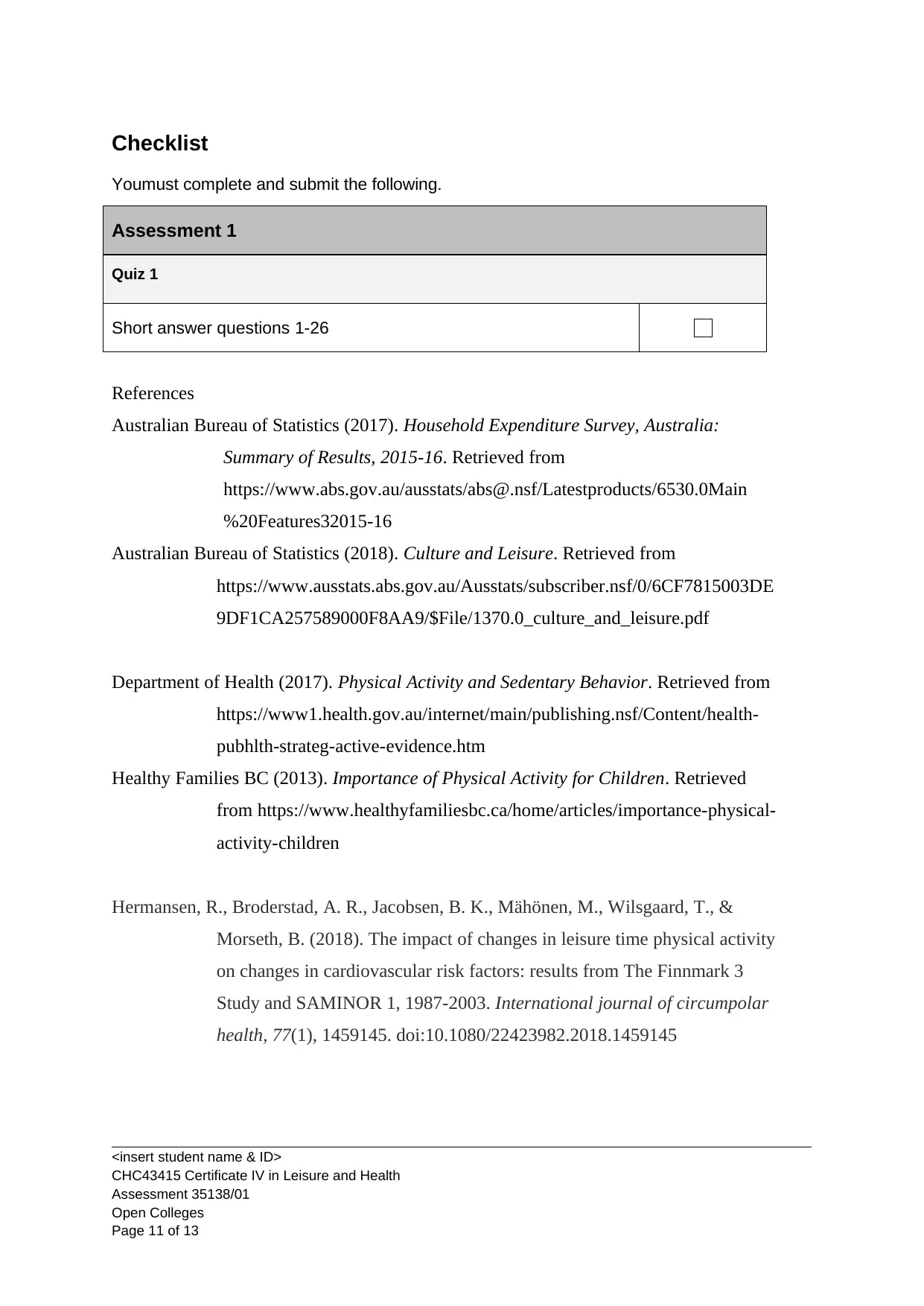
Checklist
Youmust complete and submit the following.
Assessment 1
Quiz 1
Short answer questions 1-26
References
Australian Bureau of Statistics (2017). Household Expenditure Survey, Australia:
Summary of Results, 2015-16. Retrieved from
https://www.abs.gov.au/ausstats/abs@.nsf/Latestproducts/6530.0Main
%20Features32015-16
Australian Bureau of Statistics (2018). Culture and Leisure. Retrieved from
https://www.ausstats.abs.gov.au/Ausstats/subscriber.nsf/0/6CF7815003DE
9DF1CA257589000F8AA9/$File/1370.0_culture_and_leisure.pdf
Department of Health (2017). Physical Activity and Sedentary Behavior. Retrieved from
https://www1.health.gov.au/internet/main/publishing.nsf/Content/health-
pubhlth-strateg-active-evidence.htm
Healthy Families BC (2013). Importance of Physical Activity for Children. Retrieved
from https://www.healthyfamiliesbc.ca/home/articles/importance-physical-
activity-children
Hermansen, R., Broderstad, A. R., Jacobsen, B. K., Mähönen, M., Wilsgaard, T., &
Morseth, B. (2018). The impact of changes in leisure time physical activity
on changes in cardiovascular risk factors: results from The Finnmark 3
Study and SAMINOR 1, 1987-2003. International journal of circumpolar
health, 77(1), 1459145. doi:10.1080/22423982.2018.1459145
<insert student name & ID>
CHC43415 Certificate IV in Leisure and Health
Assessment 35138/01
Open Colleges
Page 11 of 13
Youmust complete and submit the following.
Assessment 1
Quiz 1
Short answer questions 1-26
References
Australian Bureau of Statistics (2017). Household Expenditure Survey, Australia:
Summary of Results, 2015-16. Retrieved from
https://www.abs.gov.au/ausstats/abs@.nsf/Latestproducts/6530.0Main
%20Features32015-16
Australian Bureau of Statistics (2018). Culture and Leisure. Retrieved from
https://www.ausstats.abs.gov.au/Ausstats/subscriber.nsf/0/6CF7815003DE
9DF1CA257589000F8AA9/$File/1370.0_culture_and_leisure.pdf
Department of Health (2017). Physical Activity and Sedentary Behavior. Retrieved from
https://www1.health.gov.au/internet/main/publishing.nsf/Content/health-
pubhlth-strateg-active-evidence.htm
Healthy Families BC (2013). Importance of Physical Activity for Children. Retrieved
from https://www.healthyfamiliesbc.ca/home/articles/importance-physical-
activity-children
Hermansen, R., Broderstad, A. R., Jacobsen, B. K., Mähönen, M., Wilsgaard, T., &
Morseth, B. (2018). The impact of changes in leisure time physical activity
on changes in cardiovascular risk factors: results from The Finnmark 3
Study and SAMINOR 1, 1987-2003. International journal of circumpolar
health, 77(1), 1459145. doi:10.1080/22423982.2018.1459145
<insert student name & ID>
CHC43415 Certificate IV in Leisure and Health
Assessment 35138/01
Open Colleges
Page 11 of 13
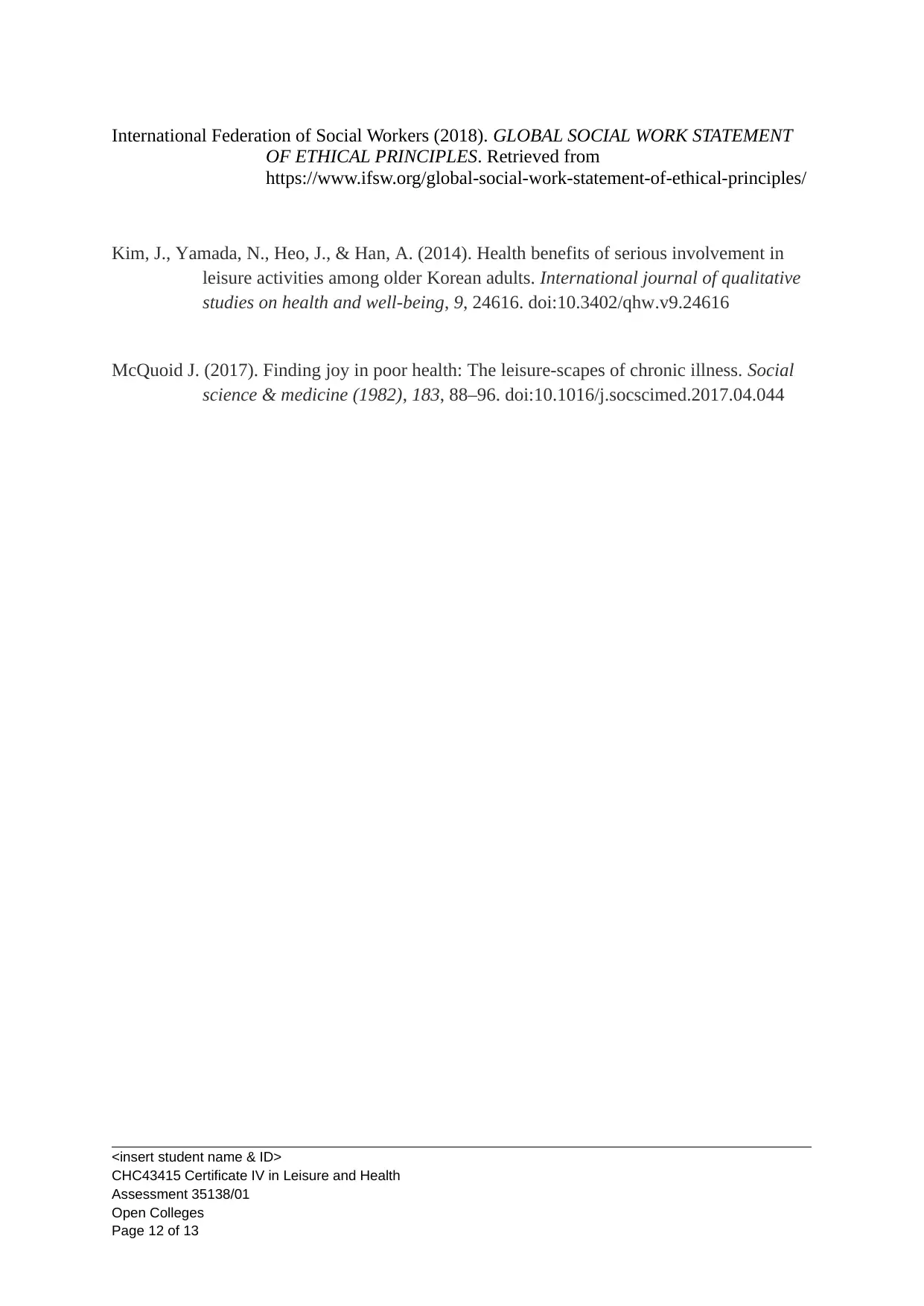
International Federation of Social Workers (2018). GLOBAL SOCIAL WORK STATEMENT
OF ETHICAL PRINCIPLES. Retrieved from
https://www.ifsw.org/global-social-work-statement-of-ethical-principles/
Kim, J., Yamada, N., Heo, J., & Han, A. (2014). Health benefits of serious involvement in
leisure activities among older Korean adults. International journal of qualitative
studies on health and well-being, 9, 24616. doi:10.3402/qhw.v9.24616
McQuoid J. (2017). Finding joy in poor health: The leisure-scapes of chronic illness. Social
science & medicine (1982), 183, 88–96. doi:10.1016/j.socscimed.2017.04.044
<insert student name & ID>
CHC43415 Certificate IV in Leisure and Health
Assessment 35138/01
Open Colleges
Page 12 of 13
OF ETHICAL PRINCIPLES. Retrieved from
https://www.ifsw.org/global-social-work-statement-of-ethical-principles/
Kim, J., Yamada, N., Heo, J., & Han, A. (2014). Health benefits of serious involvement in
leisure activities among older Korean adults. International journal of qualitative
studies on health and well-being, 9, 24616. doi:10.3402/qhw.v9.24616
McQuoid J. (2017). Finding joy in poor health: The leisure-scapes of chronic illness. Social
science & medicine (1982), 183, 88–96. doi:10.1016/j.socscimed.2017.04.044
<insert student name & ID>
CHC43415 Certificate IV in Leisure and Health
Assessment 35138/01
Open Colleges
Page 12 of 13
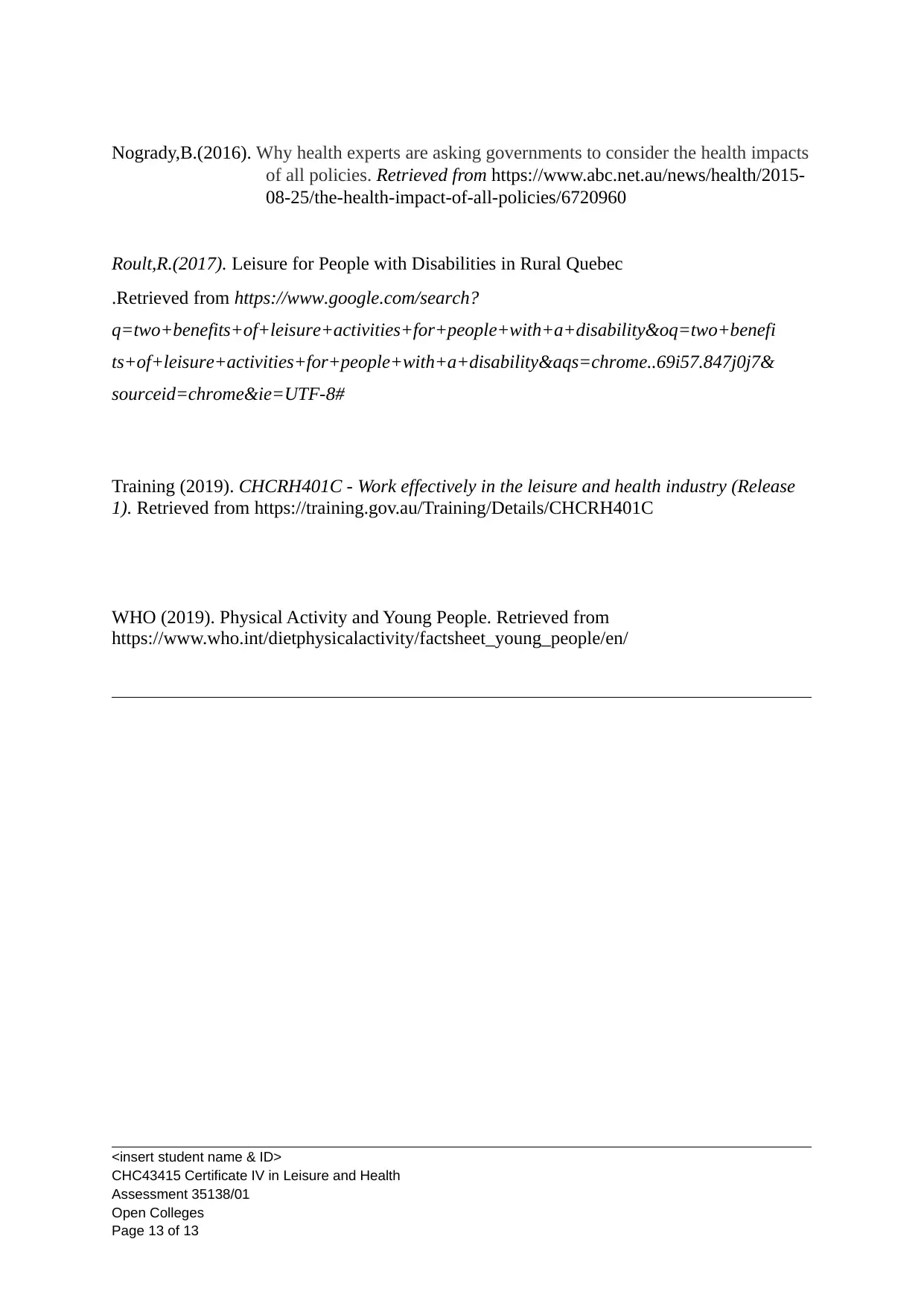
Nogrady,B.(2016). Why health experts are asking governments to consider the health impacts
of all policies. Retrieved from https://www.abc.net.au/news/health/2015-
08-25/the-health-impact-of-all-policies/6720960
Roult,R.(2017). Leisure for People with Disabilities in Rural Quebec
.Retrieved from https://www.google.com/search?
q=two+benefits+of+leisure+activities+for+people+with+a+disability&oq=two+benefi
ts+of+leisure+activities+for+people+with+a+disability&aqs=chrome..69i57.847j0j7&
sourceid=chrome&ie=UTF-8#
Training (2019). CHCRH401C - Work effectively in the leisure and health industry (Release
1). Retrieved from https://training.gov.au/Training/Details/CHCRH401C
WHO (2019). Physical Activity and Young People. Retrieved from
https://www.who.int/dietphysicalactivity/factsheet_young_people/en/
<insert student name & ID>
CHC43415 Certificate IV in Leisure and Health
Assessment 35138/01
Open Colleges
Page 13 of 13
of all policies. Retrieved from https://www.abc.net.au/news/health/2015-
08-25/the-health-impact-of-all-policies/6720960
Roult,R.(2017). Leisure for People with Disabilities in Rural Quebec
.Retrieved from https://www.google.com/search?
q=two+benefits+of+leisure+activities+for+people+with+a+disability&oq=two+benefi
ts+of+leisure+activities+for+people+with+a+disability&aqs=chrome..69i57.847j0j7&
sourceid=chrome&ie=UTF-8#
Training (2019). CHCRH401C - Work effectively in the leisure and health industry (Release
1). Retrieved from https://training.gov.au/Training/Details/CHCRH401C
WHO (2019). Physical Activity and Young People. Retrieved from
https://www.who.int/dietphysicalactivity/factsheet_young_people/en/
<insert student name & ID>
CHC43415 Certificate IV in Leisure and Health
Assessment 35138/01
Open Colleges
Page 13 of 13
1 out of 13
Related Documents
Your All-in-One AI-Powered Toolkit for Academic Success.
+13062052269
info@desklib.com
Available 24*7 on WhatsApp / Email
![[object Object]](/_next/static/media/star-bottom.7253800d.svg)
Unlock your academic potential
© 2024 | Zucol Services PVT LTD | All rights reserved.





